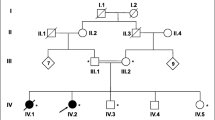Summary
A brother and sister developed epilepsy at the age of 28 and 30 years respectively, and were subsequently found to have neuroacanthocytosis. The brother developed tics, and a tendency to self-mutilate a year later, but his sister had not developed any movement disorder in the 5 years since the onset of epilepsy. In families with epilepsy, the diagnosis of neuroacanthocytosis should be considered, particularly when one family member has tics or other involuntary movements.
Similar content being viewed by others
References
Critchley EMR, Betts JJ, Nicholson JT, et al (1970) Acanthocytosis, normolipoproteinemia and multiple tics. Postgrad Med J 46:698–701
Estes JW, Morley TJ, Levine IM, Emerson CP (1967) A new hereditary acanthocytosis syndrome. Am J Med 42:868–881
Hardie RJ (1989) Acanthocytosis and neurological impairment — a review. Q J Med 71:291–301
Hardie RJ, Pullon HWH, Harding AE, Owen JS, Pires M, Daniels GL, Imai Y, Misra VP, King RHM, Jacobs JM, Tippett P, Duchen LW, Thomas PK, Marsden CD (1991) Acanthocytosis — a clinical, haematological and pathological study of 19 cases. Brain 114:13–49
Levine IM, Estes JW, Looney JM (1968) Hereditary neurological disease with acanthocytosis: a new syndrome. Arch Neurol 19:403–409
Meierkord H, Shorvon S (1990) Epilepsie bei Neuroakanthozytose. Nervenarzt 61:692–694
Sakai T, Mawatari S, Iwashita H, Goto I, Kuroiwa Y (1981) Choreoacanthocytosis. Clues to clinical diagnosis. Arch Neurol 38:335–338
Serra S, Xerra A, Scribano E, Meduri M, Di Perri R (1987) Computerized tomography in amyotrophic choreo-acanthocytosis. Neuroradiology 29:480–482
Vance JM, Pericak-Vance, Bowman MH, Payne CS, Fredane L, Siddique T, Roses AD, Massey EW (1987) Chorea-acanthocytosis: a report of three new families and implications for genetic counselling. Am J Med Genet 28:403–410
Vita G, Serra S, Dattola R, Santoro M, Toscano A, Venuto C, Carrozza G, Baradello A (1989) Peripheral neuropathy in amyotrophic choreo-acanthocytosis. Ann Neurol 26:583–587
Yamamoto T, Hirose G, Shimazaki K, Takado S, Koseogawa H, Saeki M (1982) Movement disorders of familial neuroacanthocytosis syndrome. Arch Neurol 39:298–301
Author information
Authors and Affiliations
Rights and permissions
About this article
Cite this article
Schwartz, M.S., Monro, P.S. & Leigh, P.N. Epilepsy as the presenting feature of neuroacanthocytosis in siblings. J Neurol 239, 261–262 (1992). https://doi.org/10.1007/BF00810348
Received:
Revised:
Accepted:
Issue Date:
DOI: https://doi.org/10.1007/BF00810348




